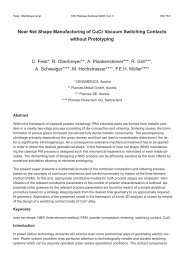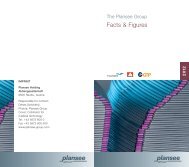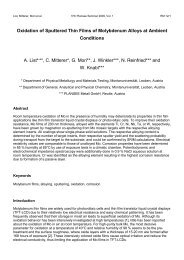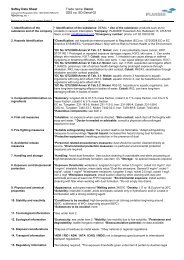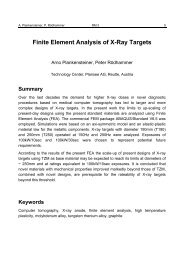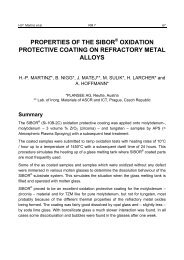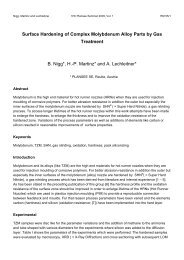Investigation of Solid Solution Hardening in Molybdenum Alloys
Investigation of Solid Solution Hardening in Molybdenum Alloys
Investigation of Solid Solution Hardening in Molybdenum Alloys
Create successful ePaper yourself
Turn your PDF publications into a flip-book with our unique Google optimized e-Paper software.
RM 18/8 17th Plansee Sem<strong>in</strong>ar 2009, Vol. 1 Wesemann, H<strong>of</strong>fmann et al.<br />
followed by tantalum. Rhenium exhibits a moderate harden<strong>in</strong>g rate while SSH was only very weak for<br />
titanium and tungsten at this temperature. The hardness values at room temperature showed a<br />
cont<strong>in</strong>uous <strong>in</strong>crease with <strong>in</strong>creas<strong>in</strong>g solute content for molybdenum-tantalum, molybdenum-titanium and<br />
molybdenum-tungsten alloys (Fig. 7). For the molybdenum-chromium alloys a decrease <strong>in</strong> the Vickers<br />
hardness for very low solute content (0.5%Cr) was observed. At higher concentrations SSH was<br />
observed. Rhenium showed a similar phenomenon <strong>of</strong> a decreas<strong>in</strong>g Vickers hardness up to<br />
concentrations <strong>of</strong> 3% rhenium. This effect is known as solid solution s<strong>of</strong>ten<strong>in</strong>g effect <strong>in</strong> literature and can<br />
not be described by SSH theories. For the harden<strong>in</strong>g rate dHV10/dc <strong>of</strong> rhenium a literature value was<br />
used [3]. In [3] the alloy s<strong>of</strong>ten<strong>in</strong>g effect has a weak impact on the total harden<strong>in</strong>g rate for alloy<br />
conta<strong>in</strong><strong>in</strong>g up to 41 wt.% rhenium.<br />
Table II: Material parameters determ<strong>in</strong>ed on the molybdenum-chromium alloys and pure molybdenum<br />
Mo Mo0.5Cr Mo1.0Cr Mo2.0Cr Mo3.0Cr<br />
Measured solute [at.%] - 0.6 1.0 2.0 3.0<br />
Gra<strong>in</strong> size [µm] 367 374 284 189 177<br />
Taylor factor 2.91 n.d. 2.99 n.d. 3.05<br />
Lattice parameter [Å] 3.14779 3.14763 3.14809 3.14564 3.14522<br />
Modulus <strong>of</strong> rigidity [GPa] n.d. 117.5 117.4 116.0 115.7<br />
Rp0.2 / ReH at 500°C [MPa] 28 / - n.d. 81 / - 143 / - - / 206<br />
Rm at 500°C [MPa] 252 n.d. 324 424 353<br />
A at 500°C [%] 52 n.d. 38.1 20.9 5.7<br />
Table III: Material parameters determ<strong>in</strong>ed on the molybdenum-rhenium alloys<br />
Mo0.5Re Mo1.0Re Mo2.0Re Mo3.0Re Mo5.0Re<br />
Measured solute [at.%] 0.5 1.0 2.0 3.0 5.0<br />
Gra<strong>in</strong> size [µm] 245 248 254 225 170<br />
Taylor factor n.d. n.d. 2.88 n.d. 2.89<br />
Lattice parameter [Å] 3.14763 3.14809 3.14674 3.14564 3.14522<br />
Modulus <strong>of</strong> rigidity [GPa] 119.2 119.8 122.1 123 122.6<br />
Rp0.2 / ReH at 500°C [MPa] n.d. n.d. - / 58 - / 95 - / 136<br />
Rm at 500°C [MPa] n.d. n.d. 313 352 385<br />
A at 500°C [%] n.d. n.d. 53.9 47.7 40<br />
Table IV: Material parameters determ<strong>in</strong>ed on the molybdenum-tantalum alloys<br />
Mo0.5Ta Mo1.0Ta Mo2.0Ta Mo3.0Ta<br />
Measured solute [at.%] 0.4 0.9 2.0 3.0<br />
Gra<strong>in</strong> size [µm] 173 220 223 266<br />
Taylor factor n.d. n.d. n.d. 2.93<br />
Lattice parameter [Å] 3.1491 3.14966 3.1499 3.152<br />
Modulus <strong>of</strong> rigidity [GPa] n.d. n.d. n.d. n.d.<br />
Rp0.2 / ReH at 500°C [MPa] n.d. - / 58 - / 106 - / 122<br />
Rm at 500°C [MPa] n.d. 304 372 384<br />
A at 500°C [%] n.d. 45.9 41.8 39.5





